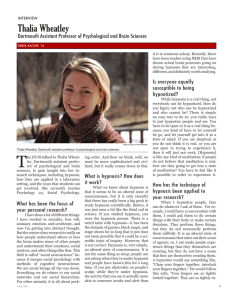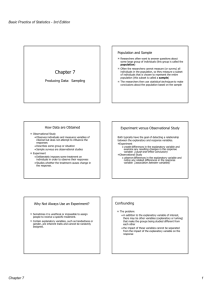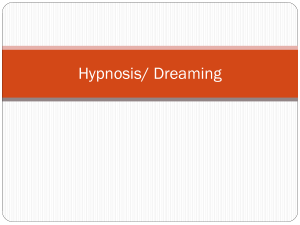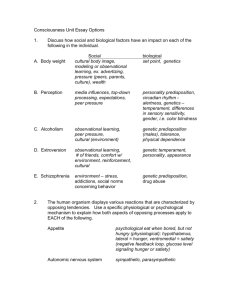342529Outline_Notes_for_M18-19_2
advertisement
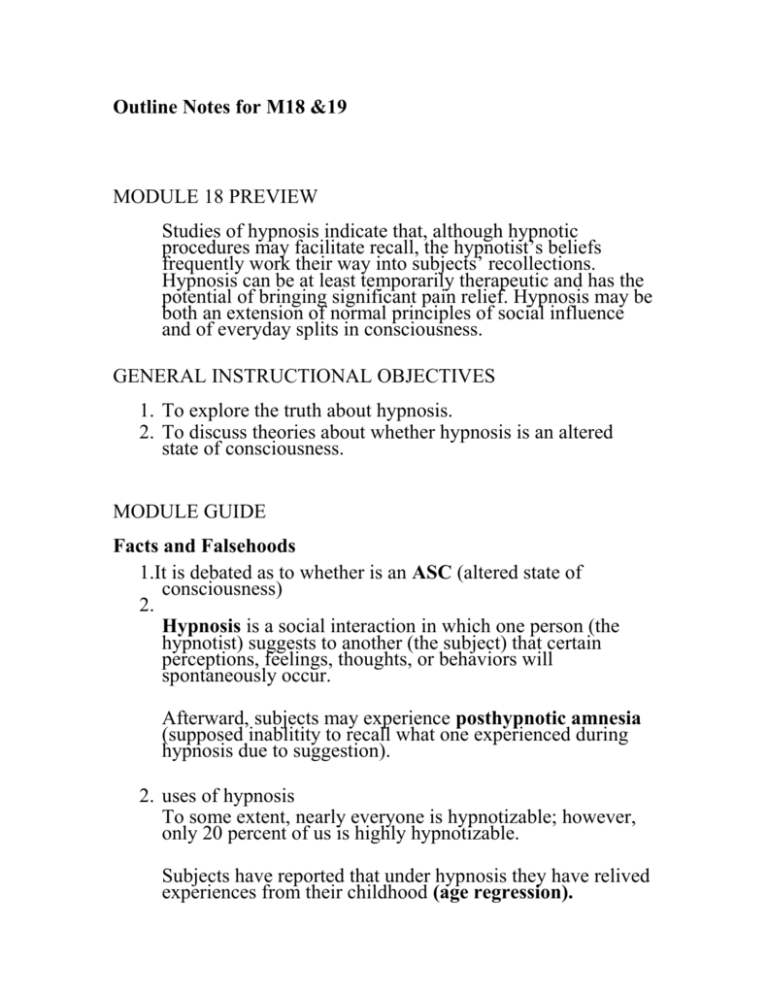
Outline Notes for M18 &19 MODULE 18 PREVIEW Studies of hypnosis indicate that, although hypnotic procedures may facilitate recall, the hypnotist’s beliefs frequently work their way into subjects’ recollections. Hypnosis can be at least temporarily therapeutic and has the potential of bringing significant pain relief. Hypnosis may be both an extension of normal principles of social influence and of everyday splits in consciousness. GENERAL INSTRUCTIONAL OBJECTIVES 1. To explore the truth about hypnosis. 2. To discuss theories about whether hypnosis is an altered state of consciousness. MODULE GUIDE Facts and Falsehoods 1.It is debated as to whether is an ASC (altered state of consciousness) 2. Hypnosis is a social interaction in which one person (the hypnotist) suggests to another (the subject) that certain perceptions, feelings, thoughts, or behaviors will spontaneously occur. Afterward, subjects may experience posthypnotic amnesia (supposed inablitity to recall what one experienced during hypnosis due to suggestion). 2. uses of hypnosis To some extent, nearly everyone is hypnotizable; however, only 20 percent of us is highly hypnotizable. Subjects have reported that under hypnosis they have relived experiences from their childhood (age regression). Although hypnotic procedures may help someone to recall something, the hypnotist’s beliefs frequently work their way into the subject’s recollections. Hypnotically refreshed memories often combine fact w/ fiction. Research indicates that hypnotized people cannot be made to act against their will any more than nonhypnotized people can. Hypnosis can be at least temporarily therapeutic through posthypnotic suggestion – suggestions made during hypnosis and carried out after subject is no longer hypnotized to control undesired symptoms/behaviors Ex. Alleviate headaches, asthma, warts, smoking, nail biting (Studies show their maybe no great benefits then other methods, positive suggestion may work just as well, research results vary) Hypnotizable people can enjoy significant pain relief. One explanation is that this occurs through dissociation, a split between different levels of consciousness. Is Hypnosis an Altered State of Consciousness? 3. Some argue that hypnosis is a by-product of normal social and cognitive processes and thus not a unique state of consciousness. These skeptics note that behaviors produced through hypnotic procedures can also be produced without them. “Hypnotized” people may be acting the role of “good hypnotic subjects” and allowing the hypnotist to direct their fantasies. Others believe that hypnosis is more than imaginative acting. They note that hypnotized subjects sometimes carry out suggested behaviors on cue, even when they believe no one is watching them. Furthermore, they argue that certain phenomena are unique to hypnosis, for example, the reduction of pain and the compelling hallucinations. The divided-consciousness theory of hypnosis argues that hypnosis involves dissociation that is more extreme than the everyday dissociations that occur in our information processing. Hilgard suggests that a hidden observer accounts for a hypnotized subject’s awareness of experiences that go unreported during hypnosis. MODULE 19 PREVIEW Psychoactive drugs alter consciousness. Depressants act by depressing neural functioning. Although their effects are pleasurable, they impair memory and self-awareness and may have other physical consequences. Stimulants act at the synapses by influencing the brain’s neurotransmitters. Their effects depend on dosage and the user’s personality and expectations. Hallucinogens can distort judgment of time and can alter sensations and perceptions. About one-third of those who survive a brush with death later recall visionary experiences. Some scientists point out that such near-death experiences closely parallel reports of hallucinations. GENERAL INSTRUCTIONAL OBJECTIVES 1. To identify the effects of various drugs. 2. To describe the near-death experience as compared to experiences while under the influence of drugs. MODULE GUIDE Dependence and Addiction 1. nature of drug dependence, and identify some common misconceptions about addiction. Psychoactive drugs are chemicals that change perceptions and moods. Continued use of a psychoactive drug produces tolerance, and cessation of use may produce the undesirable side effects of withdrawal. The pain of withdrawal and intense craving for a dose indicates a physical dependence. People can also develop psychological dependence, particularly for drugs used to relieve stress. Many drug researchers believe the following three myths about addiction are false: (1) Medical drugs, for example, those used to control pain, are powerfully addictive; (2) addictions cannot be overcome voluntarily but only through treatment; and (3) we can extend the concept of addiction to cover a whole spectrum of repetitive, pleasure-seeking behaviors such as overeating, exercise, gambling, sex, and surfing the Internet. Psychoactive Drugs 2. physiological and psychological effects of depressants, stimulants, and hallucinogens. *Depressants such as alcohol, the barbiturates, and the opiates- morphine & heroin, act by depressing neural functioning. Each offers its own pleasures, but at the cost of impaired memory and self-awareness or other physical consequences. Ex. Alcohol slows the sympathetic nervous systems activity Affects: Judgement, memory, decreases REM sleep, selfawareness, attention, brain chemistry, etc. Ex. Use of opiates can cause the brain to stop producing it’s own natural opiates (endorphins) Withdrawal will be terrible since the brain will not have its normal painkilling neurotransmitters *Stimulants, such as caffeine, nicotine, and the more powerful amphetamines and cocaine, act by stimulating neural functioning. As with nearly all psychoactive drugs, they act at the synapses by influencing the brain’s neurotransmitters. Stimulates can deplete the brains supply of neurotransmitters (ex. dopamine, serotonin, nerepinephrine ) & Block reuptake of neurotransmitters Increase heart, breathing blood sugar, & energy rates their effects depend on dosage and the user’s personality and expectations. Ecstasy (MDMA) is both a stimulate & hallucinogen *Hallucinogens, such as LSD and marijuana (with THC), can distort the user’s judgments of time and, depending on the setting, can alter sensations and perceptions. Ex. LSD mimics and therefore block neurotransmitters like serotonin Ex. Marijuana – THC sensitive receptors in the frontal lobe, limbic system, motor cortex The brain as natural pain killers SEE . 295 Chart is excellent Influences on Drug Use 3. factors that contribute to drug use Drug use among teenagers and young adults decreased during the 1980s, as attitudes changed, and began a rebound during the mid-1990s. One psychological factor that contributes to drug use is the feeling that one’s life is meaningless and directionless. Studies reveal that heavy drug users often have experienced significant stress or failure and are depressed. In addition, social factors such as peer pressure may lead people, especially teenagers, to experiment with—and become dependent on—drugs. Some people also seem to have a greater biological susceptibility to dependence on drugs. 4. (Close-Up) Describe the near-death experience and the controversy over whether it provides evidence for a mind-body dualism. About one-third of those who have survived a brush with death later recall near-death experiences. These experiences are marked by out-of-body sensations, visions of tunnels and bright lights, and intense feelings of joy, love, and peace. Dualists, who believe the mind and body are two distinct entities, interpret these experiences as evidence of human immortality. Monists, who presume the mind and body are different aspects of the same thing, point out that reports of such experiences closely parallel reports of hallucinations. Lecture/Discussion Topic: Caffeine— Caffeine is perhaps the most popular, as well as one of the most ancient, drugs. Nearly everyone ingests this drug every day in the form of coffee, tea, cocoa, soft drinks, or headache remedies. The drug occurs naturally in more than 60 plants and trees that have been cultivated by humans since the beginning of recorded history. Caffeine is one of the methylxanthines that stimulate certain neurotransmitters in the central nervous system. It can temporarily increase heart rate, metabolism, and stomach-acid secretion. In addition, it dilates some blood vessels and constricts others, it wards off drowsiness, and it increases alertness. Research has indicated that caffeine shortens reaction time but has little effect on verbal fluency, numerical reasoning, or short-term memory. Although some researchers have claimed that caffeine may enhance an athlete’s endurance, evidence is inconclusive. Caffeine can produce trembling, chronic muscle tension, throbbing headaches, depression, and insomnia, depending on weight and physical condition, as well as the amount consumed. Lecture/Discussion Topic: Rohypnol—A Date Rape Drug Estimated to be seven to ten times more potent than valium, Rohypnol produces profound, prolonged sedation, a feeling of well-being, and short-term memory loss. Legally prescribed in England and 26 other countries for insomnia and as a preoperative anesthetic, it has never been approved for use in the United States. However, in the mid-1990s it became increasingly popular among U.S. teens and young adults as a “party drug.” Tasteless, odorless, and colorless, it became a tool of predators who spike the drinks of unsuspecting young women and then rape them. The drug causes sedation within 15 minutes and the effects are boosted further by alcohol or marijuana. In some cases women report passing out and awakening briefly to find themselves being sexually assaulted. In other cases, they have no memory of being raped, although there is evidence of it. There seems to be a common thread of “I can’t remember what happened to me.” helpful guidelines for young women to protect themselves from date rape drugs: 1. Don’t drink a beverage you did not open yourself. 2. Don’t exchange or share drinks with anyone. 3. Don’t accept a drink from a punch bowl. 4. Don’t drink from a container that’s being passed around. 5. Don’t leave your drink unattended. 6. Don’t drink anything that has an unusual taste or appearance. 7. If someone orders you a drink from a bar, accompany the person who orders the drink and watch it being poured. Carry the drink yourself.



